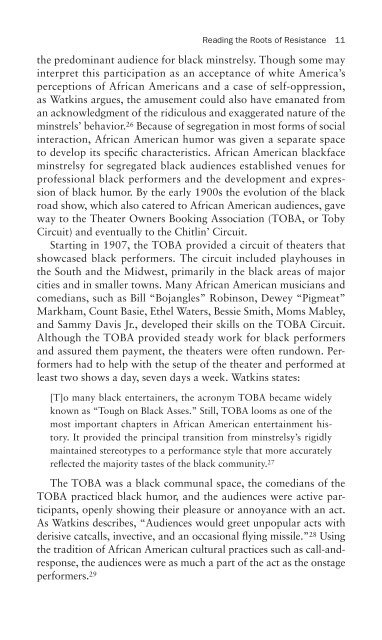Revolution Televised.pdf
Revolution Televised.pdf
Revolution Televised.pdf
Create successful ePaper yourself
Turn your PDF publications into a flip-book with our unique Google optimized e-Paper software.
Reading the Roots of Resistance 11<br />
the predominant audience for black minstrelsy. Though some may<br />
interpret this participation as an acceptance of white America’s<br />
perceptions of African Americans and a case of self-oppression,<br />
as Watkins argues, the amusement could also have emanated from<br />
an acknowledgment of the ridiculous and exaggerated nature of the<br />
minstrels’ behavior. 26 Because of segregation in most forms of social<br />
interaction, African American humor was given a separate space<br />
to develop its specific characteristics. African American blackface<br />
minstrelsy for segregated black audiences established venues for<br />
professional black performers and the development and expression<br />
of black humor. By the early 1900s the evolution of the black<br />
road show, which also catered to African American audiences, gave<br />
way to the Theater Owners Booking Association (TOBA, or Toby<br />
Circuit) and eventually to the Chitlin’ Circuit.<br />
Starting in 1907, the TOBA provided a circuit of theaters that<br />
showcased black performers. The circuit included playhouses in<br />
the South and the Midwest, primarily in the black areas of major<br />
cities and in smaller towns. Many African American musicians and<br />
comedians, such as Bill “Bojangles” Robinson, Dewey “Pigmeat”<br />
Markham, Count Basie, Ethel Waters, Bessie Smith, Moms Mabley,<br />
and Sammy Davis Jr., developed their skills on the TOBA Circuit.<br />
Although the TOBA provided steady work for black performers<br />
and assured them payment, the theaters were often rundown. Performers<br />
had to help with the setup of the theater and performed at<br />
least two shows a day, seven days a week. Watkins states:<br />
[T]o many black entertainers, the acronym TOBA became widely<br />
known as “Tough on Black Asses.” Still, TOBA looms as one of the<br />
most important chapters in African American entertainment history.<br />
It provided the principal transition from minstrelsy’s rigidly<br />
maintained stereotypes to a performance style that more accurately<br />
reflected the majority tastes of the black community. 27<br />
The TOBA was a black communal space, the comedians of the<br />
TOBA practiced black humor, and the audiences were active participants,<br />
openly showing their pleasure or annoyance with an act.<br />
As Watkins describes, “Audiences would greet unpopular acts with<br />
derisive catcalls, invective, and an occasional flying missile.” 28 Using<br />
the tradition of African American cultural practices such as call-andresponse,<br />
the audiences were as much a part of the act as the onstage<br />
performers. 29

















